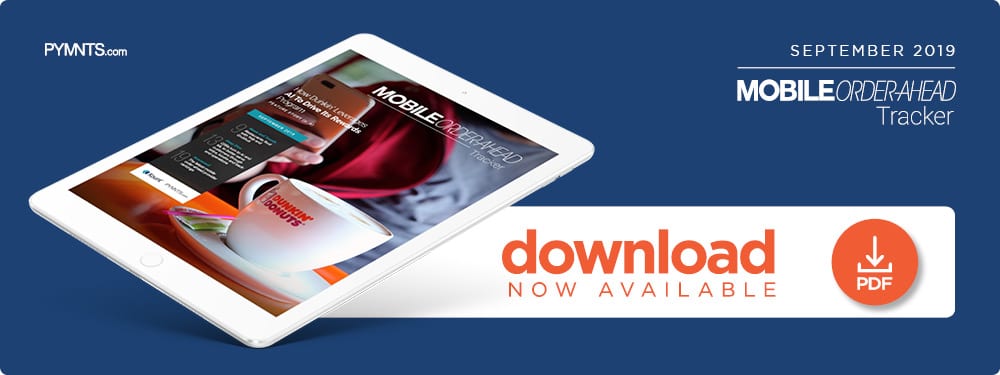Inside Dunkin’s AI-Powered Mobile Ordering App

From adding new payment options to integrating loyalty and rewards, Dunkin’ has taken many approaches to improve its mobile ordering program. But some of the more impactful upgrades have been powered by its use of artificial intelligence (AI), which it uses for analyzing customer data and sending targeted offers. In this month’s Mobile Order-Ahead Tracker, Stephanie Meltzer-Paul, Dunkin’s vice president of digital and loyalty marketing, talks with PYMNTS about using AI for targeted offers for boosting order-ahead ticket size.
Dunkin’ is one of the most widespread quick-service restaurants (QSR) brands in the world, selling coffee, donuts and breakfast items at more than 11,300 locations in 36 countries, including 8,500 restaurants across the United States. One might think that a chain with such a global footprint might not need a dedicated mobile app and program to foster customer loyalty, but with 12 million members and an additional 500,000 added every quarter, the DD Perks mobile app rewards program has proved to be a hit.
An extensive analytics framework is necessary to keep this massive number of customers satisfied, however, pushing Dunkin’ to implement artificial intelligence (AI)-driven applications to enhance the mobile customer experience. Stephanie Meltzer-Paul, Dunkin’s vice president of digital and loyalty marketing, recently spoke with PYMNTS about how DD Perks entices mobile app customers to make return visits and how Dunkin’ leverages AI to assist both members and other customers.
How DD Perks Works
DD Perks leverages a points-based system to foster return visits, and it is similar to many of its competitors’ offerings. Members earn five points for every dollar spent, with 200 points earning them a free beverage. Members are periodically given additional benefits, such as a free birthday beverage or discounted items for special events, such as local sports team victories.
“As an example, we recently celebrated the start of summer with three times the points on medium or large … iced or frozen beverages,” Meltzer-Paul said.
DD Perks accounts for approximately 13 percent of all Dunkin’ sales in the U.S., but this growth was stymied because customers were required to preload credit cards into their apps to use the program. Many customers were hesitant to do so, fearing security breaches. Dunkin’ is no stranger to such attacks and suffered from data breaches in November and February.
Dunkin’ took these concerns to heart and launched a pilot program in April at 1,000 of its U.S. locations that allowed customers to receive rewards no matter how they paid. All they had to do to earn points was scan a QR code on the Dunkin’ app or swipe a new physical membership card. Meltzer-Paul noted that Dunkin’ plans to expand the program nationwide in the near future.
The rise of mobile ordering has even affected how Dunkin’ designs its physical store locations. Its new wave of “Next-Generation” stores include much larger mobile order pick-up areas that are placed close to the entrance, allowing guests to skip the line. Digital order status boards will also be implemented to help customers keep track of their orders.
Dunkin’ Runs On AI
DD Perks also provides Dunkin’ with valuable insights into their app users’ spending habits in addition to promoting customer loyalty. The program tracks their favorite menu items, as well as how often they order and what time of day.
“We collect data to make our mobile app and DD Perks program even more valuable and relevant to our guests,” Meltzer-Paul explained. “For instance, we can analyze a guest’s buying patterns so we can offer up more relevant future offers and promotions through DD Perks and suggest new products they may be interested in trying.”
If a guest orders a Boston cream donut every Monday for an extended period of time, for example, then skips a week, Dunkin’s AI can send a coupon for the donut to encourage a return visit.
“We’re still early in that journey,” she said. “We’ll continue to evolve our data analytics capabilities, and AI is one area we’re exploring.”
The chain introduced ordering through Amazon Alexa and Google Assistant last year, allowing customers to link their accounts to the voice assistants and speak their orders conversationally. Dunkin’s priority remains its in-house mobile app, however.
“We find that the majority of our guests who use on-the-go mobile ordering place their orders through the Dunkin’ mobile app, and we’re focusing our efforts on making the in-app ordering experience even quicker and more seamless for them,” Meltzer-Paul explained.
The Future Of Dunkin’
Dunkin’ is also implementing a number of new features to compete with other coffee giants. The chain partnered with Grubhub and Seamless to offer delivery options in New York City, which it plans to expand to other major markets by the end of the year. Dunkin’ also recently announced a partnership with Beyond Meat to provide vegetarian meat substitutes for its breakfast sandwiches.
Dunkin’ may be a large chain, but it does not take much for customers to switch to another QSR. Further innovations in its mobile app, rewards programs and AI will be critical if Dunkin’ wants to maintain its presence.

